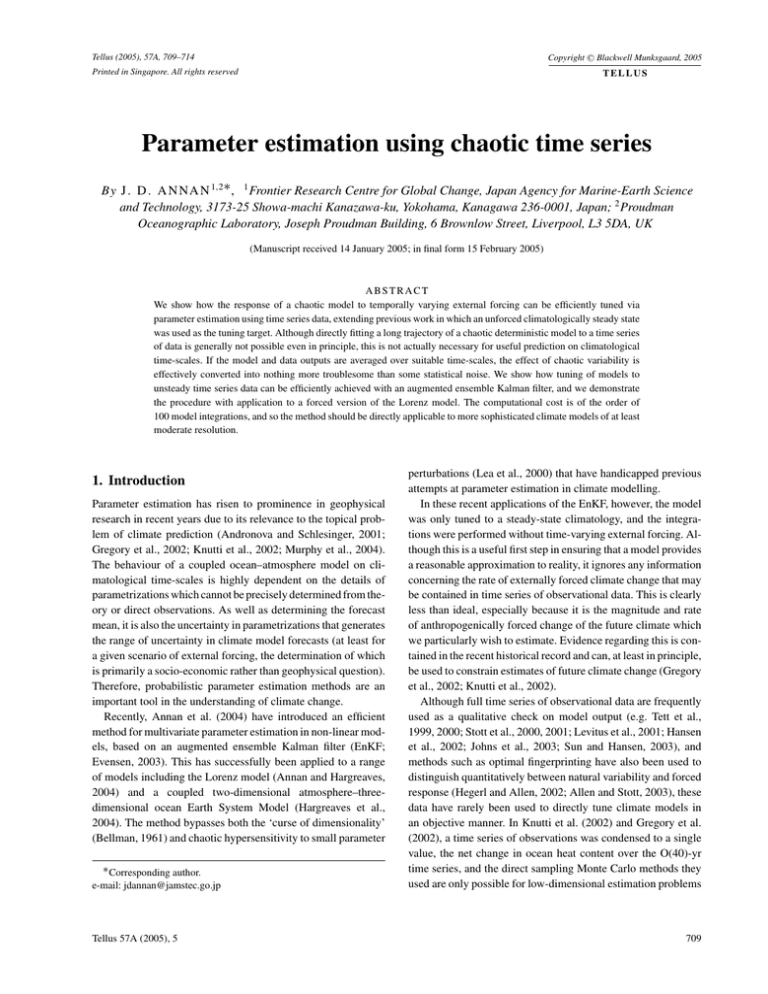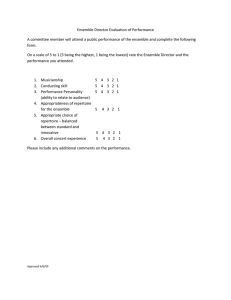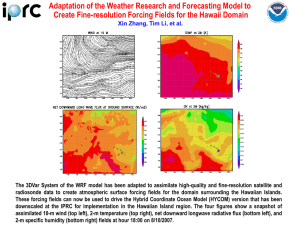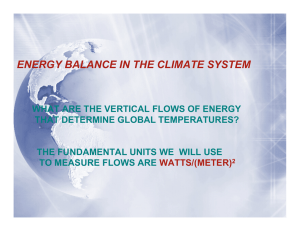
C Blackwell Munksgaard, 2005
Copyright Tellus (2005), 57A, 709–714
Printed in Singapore. All rights reserved
TELLUS
Parameter estimation using chaotic time series
By J . D . A N NA N 1,2 ∗ , 1 Frontier Research Centre for Global Change, Japan Agency for Marine-Earth Science
and Technology, 3173-25 Showa-machi Kanazawa-ku, Yokohama, Kanagawa 236-0001, Japan; 2 Proudman
Oceanographic Laboratory, Joseph Proudman Building, 6 Brownlow Street, Liverpool, L3 5DA, UK
(Manuscript received 14 January 2005; in final form 15 February 2005)
ABSTRACT
We show how the response of a chaotic model to temporally varying external forcing can be efficiently tuned via
parameter estimation using time series data, extending previous work in which an unforced climatologically steady state
was used as the tuning target. Although directly fitting a long trajectory of a chaotic deterministic model to a time series
of data is generally not possible even in principle, this is not actually necessary for useful prediction on climatological
time-scales. If the model and data outputs are averaged over suitable time-scales, the effect of chaotic variability is
effectively converted into nothing more troublesome than some statistical noise. We show how tuning of models to
unsteady time series data can be efficiently achieved with an augmented ensemble Kalman filter, and we demonstrate
the procedure with application to a forced version of the Lorenz model. The computational cost is of the order of
100 model integrations, and so the method should be directly applicable to more sophisticated climate models of at least
moderate resolution.
1. Introduction
Parameter estimation has risen to prominence in geophysical
research in recent years due to its relevance to the topical problem of climate prediction (Andronova and Schlesinger, 2001;
Gregory et al., 2002; Knutti et al., 2002; Murphy et al., 2004).
The behaviour of a coupled ocean–atmosphere model on climatological time-scales is highly dependent on the details of
parametrizations which cannot be precisely determined from theory or direct observations. As well as determining the forecast
mean, it is also the uncertainty in parametrizations that generates
the range of uncertainty in climate model forecasts (at least for
a given scenario of external forcing, the determination of which
is primarily a socio-economic rather than geophysical question).
Therefore, probabilistic parameter estimation methods are an
important tool in the understanding of climate change.
Recently, Annan et al. (2004) have introduced an efficient
method for multivariate parameter estimation in non-linear models, based on an augmented ensemble Kalman filter (EnKF;
Evensen, 2003). This has successfully been applied to a range
of models including the Lorenz model (Annan and Hargreaves,
2004) and a coupled two-dimensional atmosphere–threedimensional ocean Earth System Model (Hargreaves et al.,
2004). The method bypasses both the ‘curse of dimensionality’
(Bellman, 1961) and chaotic hypersensitivity to small parameter
∗ Corresponding author.
e-mail: jdannan@jamstec.go.jp
Tellus 57A (2005), 5
perturbations (Lea et al., 2000) that have handicapped previous
attempts at parameter estimation in climate modelling.
In these recent applications of the EnKF, however, the model
was only tuned to a steady-state climatology, and the integrations were performed without time-varying external forcing. Although this is a useful first step in ensuring that a model provides
a reasonable approximation to reality, it ignores any information
concerning the rate of externally forced climate change that may
be contained in time series of observational data. This is clearly
less than ideal, especially because it is the magnitude and rate
of anthropogenically forced change of the future climate which
we particularly wish to estimate. Evidence regarding this is contained in the recent historical record and can, at least in principle,
be used to constrain estimates of future climate change (Gregory
et al., 2002; Knutti et al., 2002).
Although full time series of observational data are frequently
used as a qualitative check on model output (e.g. Tett et al.,
1999, 2000; Stott et al., 2000, 2001; Levitus et al., 2001; Hansen
et al., 2002; Johns et al., 2003; Sun and Hansen, 2003), and
methods such as optimal fingerprinting have also been used to
distinguish quantitatively between natural variability and forced
response (Hegerl and Allen, 2002; Allen and Stott, 2003), these
data have rarely been used to directly tune climate models in
an objective manner. In Knutti et al. (2002) and Gregory et al.
(2002), a time series of observations was condensed to a single
value, the net change in ocean heat content over the O(40)-yr
time series, and the direct sampling Monte Carlo methods they
used are only possible for low-dimensional estimation problems
709
710
J . D . A N NA N
using simple models due to the large number of simulations
required. Multivariate parameter estimation with sophisticated
climate models is a significantly more demanding task, and it is
this gap that we hope to fill with the efficient method described
here.
Over climatological time-scales, it is not possible, even in
principle, to select the initial conditions and/or parameters of a
deterministic chaotic model in order to make its trajectory match
a long time series of real observational data within the observational errors, because such an ‘ι-shadowing trajectory’ (Gilmour,
1998; Smith and Gilmour, 1998) does not exist. Even when a
perfect model is used for idealized tests, tuning model parameters by the use of time series data has generally been found to
be a rather intractable problem (Pisarenko and Sornette, 2004).
However, when we wish to predict the climatological response
to some imposed forcing, then in fact there is no need for the
trajectory of the model to closely track that of historical observational data in all its chaotic detail; indeed, by definition,
the climatological response is that statistical component which
is independent of the precise initial conditions. Therefore, all
that we can require is that the climate of the model (under suitable external forcing) matches historical observations smoothed
over suitable climatological time-scales. Even so, brute force
approaches to this problem, based on exhaustive multifactorial
or randomized exploration of parameter space, are prohibitively
expensive unless the number of parameters to tune is extremely
small. In this short paper, we show how the EnKF method can
readily be extended in order to use time series data to efficiently
tune the response of a model to slowly varying external forcing.
We emphasize at the outset that in this paper we deliberately
ignore some significant issues that could hamper attempts at
practical application. In reality, models are imperfect, and both
the models and data may contain significant unforced variability
on multiyear time-scales that would have to be accounted for (e.g.
Levitus et al., 2000, but note also Gregory et al., 2004). In principle, this could perhaps be addressed by the use of off-diagonal
terms in the error covariance matrix; however, estimating these
might not be easy. In any case, our purpose here is simply to illustrate the existence of an efficient method by which these time
series could potentially be utilized to greater advantage than has
heretofore been the case.
2. Model and data
The Lorenz model (Lorenz, 1963) is a computationally simple
chaotic system of three variables which has frequently been used
as a demonstration tool in climate research. Palmer (1999) modified the basic model by the addition of an external forcing term,
which he used to illustrate the qualitative nature of the response
that might be expected from a small perturbation to a non-linear
system (e.g. anthopogenic forcing of the Earth’s climate). We
use his model to demonstrate how the forcing can be efficiently
determined from a time series of observations.
The equations for the forced Lorenz model are given by
x = σ (y − x) + f cos θ
(1)
y = r x − y − x z + f sin θ
(2)
z = x y − bz
(3)
where σ , b and r take the standard values 10, 8/3 and 28, respectively, and f and θ give the strength and direction of the
forcing. The response of the model is rather insensitive to the
choice of θ, so we fix this at the arbitrarily selected value of
70◦ . When projected on to the x–y plane, the unforced model’s
state vector oscillates chaotically
√ around
√ two symmetrical unstable fixed points (x, y) = ±(3 8, 3 8). When a modest positive
forcing f > 0 is applied, the model’s behaviour seems qualitatively similar over integrations of at least several characteristic
time periods, but in fact the model state is biased towards one
part of the attractor. If averaged over a sufficiently long interval,
the model’s projection into the x–y plane is biased towards the
positive quadrant, as shown in Palmer (1999); a negative forcing has the opposite effect. This bias can be quantified by, for
example, calculating the mean value of x over a sufficiently long
interval, which for | f | ≤ 5, increases in near-linear proportion
to the strength of the forcing. For sufficiently strong forcing, the
model behaviour changes qualitatively and so we apply the limit
| f | ≤ 5 throughout this paper.
We will use this model as a simple simulacrum for a climate
model, with x taking the place of global temperature, and f corresponding to the variation in radiative forcing due to natural
and anthropogenic causes. We define a ‘year’ of model integration as 1000 time units. Of course, this model cannot provide
a realistic simulation of the real climate, and our experiment is
merely intended to illustrate how a time series of data can be used
to tune a chaotic model that is subject to slowly varying forcing. Nevertheless, we make the arbitrary decision to use realistic
forcing. The four dominant sources of variability in radiative
forcing are described and estimated in Crowley (2000), and consist of volcanic dust, solar variability, anthropogenic greenhouse
gases (GHGs; predominantly CO 2 ) and sulphate aerosols. The
annually averaged estimated values for the radiative forcing effect of these factors for the years 1949–1998 are plotted in the
top half of Fig. 1. The volcanic forcing is highly variable and
is dominated by the major eruptions of El Chichon (1982) and
Mt Pinatubo (1991). The GHG forcing shows a strong upward
trend, the sulphate aerosols a smaller negative trend, and the
solar output exhibits a much lower variability on a decadal timescale. However, although these factors can be directly measured,
significant uncertainty remains as to their conversion into effective radiative forcings of the Earth’s climate system (Houghton
et al., 2001; Gregory et al., 2002). We treat these uncertainties
as a priori unknown but temporally fixed multiplicative factors
by which the four given time series of forcing terms are scaled.
Tellus 57A (2005), 5
PA R A M E T E R E S T I M AT I O N U S I N G C H AOT I C T I M E S E R I E S
711
Fig. 1. Radiative forcings (top) and model
output (bottom). Thick solid, dotted, dashed
and dot-dashed lines in the top plot show
aerosol, volcanic, solar and GHG forcings,
respectively. The thick solid line in the lower
plot shows annually averaged model output
when forced as described in the text. Thin
horizontal lines indicate zero.
Thus, the total forcing term takes the form
given by
f (t) = α1 f 1 (t) + α2 f 2 (t) + α3 f 3 (t) + α4 f 4 (t)
Pa = Pf − Pf HT (HPf HT + R)−1 HPf .
where f i are the individual constituents of the total forcing, and
α i are be determined. Although these parameters are simple scalings on the external forcing, arbitrary internal parameters of a
more complex model (e.g. those which affect the cloud feedback), which control the response to forcing, could equally well
be tuned by the method outlined in Section 3. In order to demonstrate the technique, we perform an identical twin test, generating
a synthetic time series of data by selecting the four scaling factors
independently from the normal distribution N (µ, σ ) = N (1.5,
0.25) (the selected values were, in order, 1.4, 1.5, 1.1 and 1.1 to
two significant figures) and integrating the model for a period
of 51 yr, with the first year being a spin-up from random initial
conditions. Observations are made at intervals of one time unit,
with independent observational errors drawn from N(0, 1). The
results are not sensitive to these choices unless either the observational error or sampling interval is dramatically increased.
The output from this integration is plotted in the lower half of
Fig. 1. The dominant features in the model output are the two
large troughs in the latter part of the run due to the two massive
volcanic eruptions mentioned previously, despite which there is
a small positive anthropogenically forced trend over the whole
time series. We now show how these data can be used to determine the parameters by which they were generated.
3. Method for assimilation of time series data
The Kalman filter (Kalman, 1960) is an optimal filter for linear
systems. Given a model forecast state mf with error covariance
matrix Pf , observations o (which are valid at the forecast time)
with their error covariance matrix R, the analysis state ma is
calculated by
ma = mf + Pf HT (HPf HT + R)−1 (o − Hmf ),
(4)
where H is the measurement operator that maps the model to
observations, and the analysis error covariance matrix Pa is
Tellus 57A (2005), 5
(5)
The EnKF uses an ensemble of model states as an efficient
Monte Carlo approximation to the mean and covariance matrix
of the model state. A full description and an extensive list of
applications are given in Evensen (2003), and it is notable that
although the method is only provably optimal in the case of a
linear system and limit of infinite ensemble size, in practice it
can usually handle substantial non-linearity, and a modest ensemble size of about 100 members has usually been found to be
adequate across a wide range of problems. One simple extension
of the method is to augment the model state with parameter values, in order that the parameters themselves are also estimated
along with the state variables. Here we augment the model state
with the four coefficients α i . A standard implementation of the
EnKF would involve an analysis step at each time that observations became available. After the full time series of data are
assimilated, the ensemble members should hopefully sample the
joint posterior parameter distribution. However, in practice this
approach to parameter estimation often gives rather poor results
when attempted with highly chaotic models, even in simple identical twin tests such as this. The failure of the method manifests
itself as a convergence of the parameter values to distributions
that are inconsistent with the truth (commonly termed filter divergence), as shown by Kivman (2003). In his research, a particle
filter delayed, but ultimately did not prevent, this failure from occurring. Our implementation of this sequential trajectory-fitting
approach using the EnKF for our parameter estimation problem
also results in a qualitatively similar (although quantitatively less
severe) failure which is not presented here. Of course, the apparent limitations of these and other methods do not necessarily
mean that they cannot be developed to solve parameter estimation problems of this type. Rather, the presentation here of one
possible solution is just a demonstration that the problem is in
principle tractable rather than a claim to be the best possible
method.
712
J . D . A N NA N
Although fitting every chaotic detail of the model to that of the
time series does not appear to be possible, we note that this is not
in fact necessary or even particularly desirable in order to make
meaningful predictions of climate change. Any infinitesimal discrepancy between the true and model states will rapidly grow
during the forecast interval, and on climatological time-scales,
the oscillations of model and truth around their climatological
means will be wholly independent of each other. For this reason,
it is the climatological statistics which are of primary interest,
and (by definition) these are essentially independent of the initial
conditions except perhaps in pathological cases. Lea et al. (2000)
showed that by averaging the model’s output over an adequately
long time-scale, the effect of the chaotic dynamics can be considered as nothing more than a random sampling error caused
by the limited precision with which the statistics of a finite integration interval approximate the true climatology of the model.
This sampling error is for all practical purposes indistinguishable
from Gaussian stochastic noise and scales inversely in proportion to the square root of the averaging interval. Although those
experimental results were generated with the Lorenz model, the
sensitive dependence of chaotic models to the initial conditions,
together with the central limit theorem, implies that the same
ideas will apply in the general case. Furthermore, the sampling
errors on consecutive disjoint intervals are independent, so long
as the averaging interval is long relative to the characteristic timescale of chaotic dynamics of the model. Therefore, the chaotic
variability can be treated as simple independent observational
errors on the temporally averaged observations.
We choose here to average our observations over intervals of
1 yr. For our definition of 1 yr as 1000 time units in the Lorenz
model, the standard error on the mean of one year’s worth of
observations of x is approximately 0.3 units, which value we
use as the observational error in the assimilation scheme (the
true observational error makes a negligible contribution to this
value). Using a much shorter year would result in the noise of
the climatological sample swamping the signal of the forcing
time series. The total external forcing over the first 6 yr of the
model integration in Fig. 1 has very small variability, so the
model output over this interval indicates the variability due to
this random sampling noise.
In order to assimilate climatological observations, we need
to augment the model state with appropriate climatological diagnostics. Because we are not only interested in the posterior
parameter values, but also wish to check how well the model reproduces the historical time series with these parameter values,
we treat the problem as a smoother rather than filter. This means
updating all of the previous output from the model (as well as the
current state) in the light of new measurements, so that information propagates backwards as well as forwards in time. Evensen
and Leeuwen (2000) explain in some detail how this can be readily achieved with essentially the same analysis algorithm as the
EnKF, by merely augmenting the current model state with a history of model output, which is thereby automatically updated
by new observations. They also prove that the final estimate of
model state (including parameters, in our case) is not affected by
this modification to the standard Kalman filter algorithm. In our
example, we only need to augment the set of tunable parameters
with the series of annually averaged observations to generate a
vector of 54 values for each ensemble member, and perform the
analysis in a single step at the end of the integration using the
50 annual observations of the identical twin output. The model
state itself is not needed for the analysis. By using this method,
the full time series of climatological values and parameters are
updated in a mutually consistent manner by the analysis routine, and we do not need to repeat the 50-yr integration with the
posterior parameter estimates in order to generate a consistent
hindcast. The computational costs are still dominated by the 100member ensemble integration, as is usual for EnKF applications.
We choose deliberately ignorant priors of the form α i ∈
N (1, 1) in order to investigate to what extent the data alone
can constrain the parameter values. As mentioned previously,
the magnitude of total forcing was capped at 5, this being approximately the level at which the response to forcing becomes
significantly non-linear. The output from the prior ensemble is
plotted at the top of Fig. 2. The ensemble mean is reasonably
close to the data, although the upward trend in the time series
appears slightly too shallow, as are the volcanic troughs. More
importantly, the width of the ensemble is very broad, reflecting
our prior ignorance of the parameter values.
4. Results from the identical twin test
The lower half of Fig. 2 shows the output of the ensemble Kalman
smoother. The posterior hindcast gives a very close fit to the data.
The four posterior parameter values are given by (1.3 ± 0.2,
1.7 ± 0.6, 0.9 ± 0.3, 1.0 ± 0.5) which are consistent with the
true values and substantially narrower than the prior distributions. The volcanic forcing has been significantly constrained
by the distinctive shape of the forcing and data, but the effect
of solar forcing (which is very small and varies relatively little)
is much less well defined. The GHG and aerosol forcings are
more interesting. Although they are both much larger forcings
than the solar variability, and vary by more than a factor of 2
over the hindcast interval, they also remain rather uncertain. The
mean value of α 3 is also slightly degraded, which is probably due
to the sampling error of the small ensemble. There is, however,
a substantial correlation between these two scaling parameters
across the ensemble members, with a Pearson correlation coefficient of 0.9 (the next largest pairwise correlation between the
scaling parameters is 0.3). Examining the time series of the input forcings in Fig. 1, we can see that both GHG and aerosol
forcings have very similar shapes (but opposite signs), showing
a steady increase in magnitude through the time interval. It is
not surprising therefore that their scaling coefficients cannot be
simultaneously constrained by the single time series of data, because the effects of increasing both of their scaling coefficients
Tellus 57A (2005), 5
PA R A M E T E R E S T I M AT I O N U S I N G C H AOT I C T I M E S E R I E S
713
Fig. 2. Prior (top) and posterior (bottom)
ensemble output. For each plot, the thickest
line is the ensemble mean, the two medium
width lines indicate the one standard
deviation width and the thin line shows the
model data from Fig. 1.
simultaneously will largely cancel out. Although the model used
here is in no way realistic, this ambiguity between the effects of
GHG and aerosols is known to pose a significant difficulty in the
attribution of recent climate change (Houghton et al., 2001).
Despite the chaotic nature of the model, the relationship between the tunable parameters and model output is highly linear.
In fact, the occasional truncation of the forcing to | f | ≤ 5 is the
only detectable source of non-linearity. Therefore, because the
EnKF maintains linear balance in the calculation of the posterior,
the posterior parameter and climate estimates are highly consistent, as can be demonstrated by integrating the ensemble over
the same interval, this time using the posterior parameter values
during the integration. The results from this (not shown) are very
similar to the posterior estimates, with a marginally broader ensemble width being the only sign of numerical inaccuracy. For
more complex problems, the Gaussian approximation to the error
structure implicit in the Kalman filter equations may introduce
significant inaccuracy, especially if the prior is much broader
than the posterior. In this case, the iterative approach presented
in Annan et al. (2004) and Annan and Hargreaves (2004) will
improve the accuracy and self-consistency of the output, at the
cost of requiring multiple integrations over the full time interval.
There may, of course, be other approaches which would achieve
higher accuracy at lower computational cost.
5. Conclusions
We have demonstrated how time series data can be used efficiently to constrain parameters in a chaotic model. The method
relies on the averaging of the chaotic observational data and
model output over sufficient intervals that the high-frequency
chaotic dynamics can be treated as stochastic noise, following
which the ensemble Kalman filter (or smoother) can be used
in a very similar manner to the steady-state applications previously presented. Any practical application with geophysical data
would have to address the important issue of model error, which
is not addressed here, and there also may not be such a clear
cut-off point between high-frequency chaos and low-frequency
Tellus 57A (2005), 5
climate change as in this toy example. These problems could
be expected to limit the accuracy of parameter estimates, but at
least the method outlined here may have the potential to address
this parameter estimation problem in a computationally efficient
manner.
6. Acknowledgments
I am grateful to Julia Hargreaves and the referees for their helpful
comments.
References
Allen, M. R. and Stott, P. A. 2003. Estimating signal amplitudes in
optimal fingerprinting, part I: theory. Climate Dyn. 21(5–6), 477–491.
Andronova, N. G. and Schlesinger, M. E. 2001. Objective estimation of
the probability density function for climate sensitivity. J. Geophys.
Res. 108(D8), 22 605–22 611.
Annan, J. D. and Hargreaves, J. C. 2004. Efficient parameter estimation
for a highly chaotic system. Tellus 56A, 520–526.
Annan, J. D., Hargreaves, J. C., Edwards, N. R. and Marsh, R. 2004.
Parameter estimation in an intermediate complexity Earth System
Model using an ensemble Kalman filter. Ocean Modelling 8(1–2),
135–154.
Bellman, R. 1961. Adaptive Control Processes: A Guided Tour. Princeton
University Press, Princeton, NJ.
Crowley, T. J. 2000. Causes of climate change over the past 1000 years.
Science 289, 270–277.
Evensen, G. 2003. The ensemble Kalman filter: theoretical formulation
and practical implementation. Ocean Dyn. 53, 343–367.
Evensen, G. and Leeuwen, P. J. V. 2000. An Ensemble Kalman Smoother
for non-linear dynamics. Mon. Wea. Rev. 128, 1852–1867.
Gilmour, I. 1998. Non-linear model evaluation: ι-shadowing, probabilistic prediction and weather forecasting. D. Phil thesis, Oxford
University.
Gregory, J. M., Stouffer, R. J., Raper, S. C. B., Stott, P. A. and Rayner,
N. A. 2002. An observationally based estimate of the climate sensitivity. J. Climate 15(22), 3117–3121.
Gregory, J. M., Banks, H. T., Stott, P. A., Lowe, J. A. and Palmer,
M. D. 2004. Simulated and observed decadal variability in ocean heat
content. Geophys. Res. Lett. 31(15), L15312.
714
J . D . A N NA N
Hansen, J., Sato, M., Nazarenko, L., Ruedy, R., Lacis, A. and co-authors.
2002. Climate forcings in Goddard Institute for Space Studies SI2000
simulations. J. Geophys. Res. 107(D18), 4347–4384.
Hargreaves, J. C., Annan, J. D., Edwards, N. R. and Marsh, R. 2004.
Climate forecasting using an intermediate complexity Earth System
Model and the ensemble Kalman filter. Climate Dyn. 23(7–8), 745–
760.
Hegerl, G. C. and Allen, M. R. 2002. Origins of model-data discrepancies
in optimal fingerprinting. J. Climate 15(11), 1348–1356.
Houghton, J. T., Ding, Y., Griggs, D. J., Noguer, M., Linden, P. J.
V. D. and co-authors. 2001. Climate Change 2001: Contribution of
Working Group I to the Third Assessment Report of the Intergovernmental Panel on Climate Change, Cambridge University Press,
Cambridge.
Johns, T. C., Gregory, J., Ingram, W., Johnson, C., Jones, A. and coauthors. 2003. Anthropogenic climate change for 1860 to 2100 simulated with the HadCM3 model under updated emissions scenarios.
Climate Dyn. 20, 583–612.
Kalman, R. E. 1960. A new approach to linear filtering and prediction
problems. J. Basic Eng. 82D, 33–45.
Kivman, G. A. 2003. Sequential parameter estimation for stochastic systems. Non-linear Processes in Geophysics 10, 253–259.
Knutti, R., Stocker, T. F., Joos, F. and Plattner, G.-K. 2002. Constraints
on radiative forcing and future climate change from observations and
climate model ensembles. Nature 416, 719–723.
Lea, D. J., Allen, M. R. and Haine, T. W. N. 2000. Sensitivity analysis
of the climate of a chaotic system. Tellus 52A, 523–532.
Levitus, S., Antonov, J. I., Boyer, T. P. and Stephens, C. 2000. Warming
of the world ocean. Science 287, 2225–2229.
Levitus, S., Antonov, J. I., Wang, J., Delworth, T. L., Dixon, K. W.
and Broccoli, A. J. 2001. Anthropogenic warming of Earth’s climate
system. Science 292, 267–270.
Lorenz, E. N. 1963. Deterministic non-periodic flow. J. Atmos. Sci. 20,
130–141.
Murphy, J. M., Sexton, D. M. H., Barnett, D. N., Jones, G. S., Webb,
M. J. and co-authors. 2004. Quantification of modelling uncertainties
in a large ensemble of climate change simulations. Nature 430, 768–
772.
Palmer, T. N. 1999. A non-linear dynamical perspective on climate prediction. J. Climate 12, 575–591.
Pisarenko, V. F. and Sornette, D. 2004. Statistical methods of parameter
estimation for deterministically chaotic time series. Phys. Rev. E 69,
036122.
Smith, L. A. and Gilmour, I. 1998. Accountability and internal consistency in ensemble formation. In: Proceedings of the ECMWF
Workshop on Predictability, 20–22 October 1997, ECMWF, Reading,
Berkshire, UK.
Stott, P. A., Tett, S. F. B., Jones, G. S., Allen, M. R., Mitchell, J. F. B. and
co-authors. 2000. External control of twentieth-century temperature
variations by natural and anthropogenic forcings. Science 15, 2133–
2137.
Stott, P. A., Tett, S. F. B., Jones, G. S., Allen, M. R., Ingram, W. J. and coauthors. 2001. Attribution of twentieth-century temperature change to
natural and anthropogenic causes. Climate Dyn. 17, 1–22.
Sun, S. and Hansen, J. E. 2003. Climate simulations for 1951–2050 with
a coupled atmosphere–ocean model. J. Climate 16, 2807–2826.
Tett, S. F. B., Stott, P. A., Allen, M. A., Ingram, W. J. and Mitchell,
J. F. B. 1999. Causes of twentieth-century temperature change. Nature
399, 569–572.
Tett, S. F. B., Jones, G. S., Stott, P. A., Hill, D. C., Mitchell, J. F. B. and coauthors. 2000. Estimation of natural and anthropogenic contributions
to 20th century. Technical Report, Hadley Centre Technical Note 19,
Hadley Centre for Climate Prediction and Response, Meteorological
Office, RG12 2SY, UK.
Tellus 57A (2005), 5





